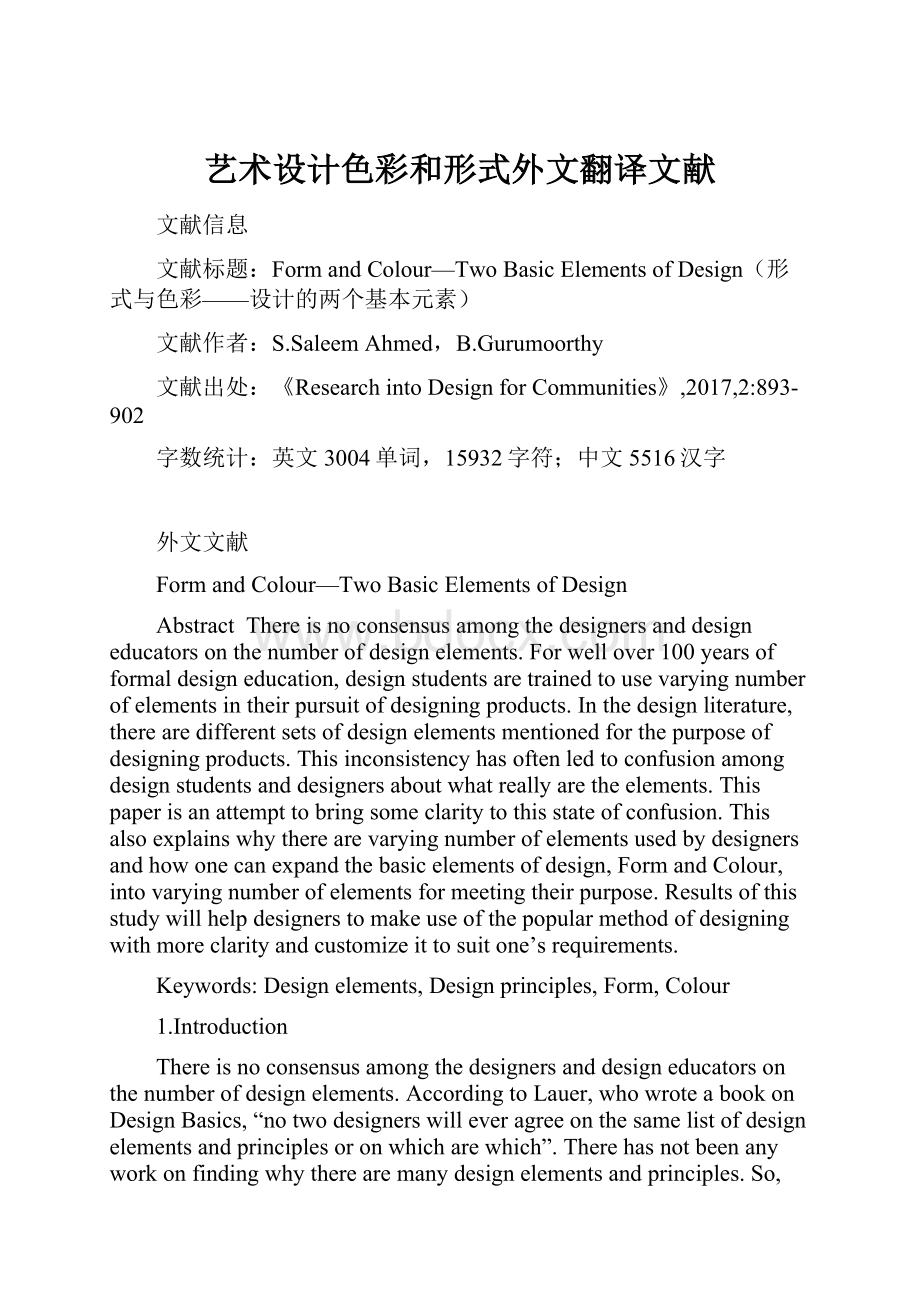艺术设计色彩和形式外文翻译文献.docx
《艺术设计色彩和形式外文翻译文献.docx》由会员分享,可在线阅读,更多相关《艺术设计色彩和形式外文翻译文献.docx(26页珍藏版)》请在冰豆网上搜索。

艺术设计色彩和形式外文翻译文献
文献信息
文献标题:
FormandColour—TwoBasicElementsofDesign(形式与色彩——设计的两个基本元素)
文献作者:
S.SaleemAhmed,B.Gurumoorthy
文献出处:
《ResearchintoDesignforCommunities》,2017,2:
893-902
字数统计:
英文3004单词,15932字符;中文5516汉字
外文文献
FormandColour—TwoBasicElementsofDesign
AbstractThereisnoconsensusamongthedesignersanddesigneducatorsonthenumberofdesignelements.Forwellover100yearsofformaldesigneducation,designstudentsaretrainedtousevaryingnumberofelementsintheirpursuitofdesigningproducts.Inthedesignliterature,therearedifferentsetsofdesignelementsmentionedforthepurposeofdesigningproducts.Thisinconsistencyhasoftenledtoconfusionamongdesignstudentsanddesignersaboutwhatreallyaretheelements.Thispaperisanattempttobringsomeclaritytothisstateofconfusion.Thisalsoexplainswhytherearevaryingnumberofelementsusedbydesignersandhowonecanexpandthebasicelementsofdesign,FormandColour,intovaryingnumberofelementsformeetingtheirpurpose.Resultsofthisstudywillhelpdesignerstomakeuseofthepopularmethodofdesigningwithmoreclarityandcustomizeittosuitone’srequirements.
Keywords:
Designelements,Designprinciples,Form,Colour
1.Introduction
Thereisnoconsensusamongthedesignersanddesigneducatorsonthenumberofdesignelements.AccordingtoLauer,whowroteabookonDesignBasics,“notwodesignerswilleveragreeonthesamelistofdesignelementsandprinciplesoronwhicharewhich”.Therehasnotbeenanyworkonfindingwhytherearemanydesignelementsandprinciples.So,thisgapispartlybeingfilledupthroughinvestigationonthedesignelementsinthispaper.
Chapman,whiledescribingtheprocessofdesigning,statedthat,“Whenartistsplantheirwork,theymustseeandthinkabouttheelementsandprinciplesofdesign.Theelementsofdesignare:
line,shape,color,texture,andvalue(lightanddark).Artistsalsouseideasknownasprinciplesofdesigntoplantheirwork.Aprincipleofdesignisaguideforrelatingthevisualelements.Someprinciplesofdesignare:
balance,rhythm,proportion,pattern,unityandvariety.”
Forwellover100yearsofformaldesigneducation,designstudentsaretrainedtousevaryingnumberofelementsintheirpursuitofdesigningproducts.Indesignliterature,therearedifferentsetsofdesignelementsmentionedforthepurposeofdesigningproducts.Thisinconsistencyhasoftenledtoconfusionamongdesignstudentsanddesignersaboutwhatreallyaretheelements.Thispaperisanattempttobringsomeclaritytothisstateofconfusion.Thisalsoexplainswhytherearevaryingnumberofelementsusedbydesignersandhowonecanexpandthebasicelementsofdesignintovaryingnumberofelementsformeetingtheirpurpose.
ElementsandPrinciplesApproachtodesignhasbeenthemethodusedwidelybyartanddesigneducatorsthroughouttheworldsincethebeginningof20thcentury.Kiminherstudiesonthehistoryofdesigntheoryinarteducationobservedthat,“theelementsandprinciplesofdesignhavetakenafirmplaceinvariousartcurricula,textbooks,andnationalandstateVisualArtsStandards”andsheconcludedthat,“Idonotexpectthatdesignelementsandprincipleswilldisappearasaspectsofarteducationinthefore-seeablefuture,orthattheirdisappearancewouldbedesirable”.Nowadaystheboundariesofthedomainofdesignarefastexpandingandmanynewbranchesofdesignsuchasinteractiondesign,webdesign,andappdesignarebeingintroduced.Itisimportanttoadapttheexistingelementsandprinciplesmethodtosuittheneedsofthenewerbranchesofdesign.
2.Overview
Worksof12authorswhohavemajorlycontributedtothefieldofdesigneducationsincethebeginningof20thcenturyhavebeenconsidered.Thedesignelementsproposedbythemhavebeenanalyzed.Inthispaper,attemptshavebeenmadetofindwhytherehasbeennoconsensusandfindoutifthereareanyuniversaldesignelementspossible.Thesehavedonebydefiningthedesignelements,criteria-checkontheproposedelements,andcategorizingtheaccepteddesignelementsbasedontheirfunction/nature/characteristics.FormandColourarethebasicdesignelementsthatfinallyemergeoutoftheanalysis.Theresultsarediscussedandtherecommendationsforapplicationtodifferentbranchesofdesignaresuggested.
3.AssumptionsandMethods
Whenpeopleengagewithproducts,itistypicallyamulti-sensoryexperience.Inadditiontoproduct’svisualform,otherproductqualitiesliketactile,auditory,sometimesolfactoryandgustatoryarealsousedinaproductexperience.Howeverproduct’svisualformisconsideredparticularlyimportantforthefollowingreasons:
(a)Visionisthedominantsenseformajorityofthepeople.
(b)Visionisasensethatiseffectiveoverdistanceandbecauseofthisproductsaretypicallyseenbeforetheyaretouched.
(c)Consumersapproachaproducttoexploreitsnon-visualqualitiesbecauseoftentheproduct’svisualforminitiallyattractedthem.
Perhapsbecauseofthesereasons,themajorityoftheliteraturefocussesonvisualaspectsincomparisontoothersenses.Visualaestheticsandvisualperceptionsarecommonlyusedtermsintheliterature.Forthepurposeofthispaper,assumptionsanddefinitionsaremadebasedonthedominanceofthevisualsense.
3.1.DefinitionofaDesignElement
Anydiscretevisualand/ortactileentityisconsideredasadesignelement.Adesigniscomposedofseveraldesignelements.Pixels,Points,Lines,andSurfacesareusedforconstructingadesigninthevirtualmedia.Theyarebuildingblocksandnotdesignelements.Atamicrolevel,Atomsarebuildingblocks.Traditionallydesignelementsaretheonesusedforcomposingtheappearanceorstylingofanewdesign.
Designelementsareunit-lessentities.So,LengthandWidthcannotbedesignelements.Designelementsareperceivedthroughvisual(optical)and/ortactilesenses.Designelementsaretheoptimalindependentvisualand/ortactileentitiesforaparticulardomainofdesign.Theyareeitherindividuallyorcollectivelyaccountforallthatweseeorfeelinaproductdesign.
3.2.Methods
Majorcontributorstotheknowledgebaseofdesignaesthetics,designeducation,anddesignphilosophyoverthelastabout100yearshavebeenconsidered.Allthedesignelementsasproposedbytheseauthorshavebeentabulatedandanalyzed.Theyhavebeensequencedtooneorder,checkedagainstthedefinitionofdesignelements,andcategorizedaccordingtotheirnature/characteristics.Theresultswereobservedandcheckedforanypatterns.
4.Analysis
DowauthoredabookonCompositionin1899.Thiswasoneofthewidelyfollowedbooksforformaltrainingofartistsanddesignersinthefirsthalfof20thcentury.SubsequentlyDenmanRossauthoredabookcalledThePureDesignin1907.ThethirdonewasonArtEducationforHighSchoolsauthoredbyLouisPrangin1908.Alltheseauthorsproposedthreedesignelements—Line,Tone,andColour.Thesebooksranintoseveraleditionsandfordecadestheseweretheonesreferred.In1972,MalcolmauthoredabookonDesignElementsandPrinciples.Severalpublicationscamesoonafter.Wehavetaken12authors,includingtheabovefour,whohavecontributedmajorlytothefieldofDesignAesthetics/ArtEducationsince1900.Table1listsallthedifferentauthorsandwhattheyproposedasdesignelements.Theorderofsequenceofthedesignelementsisthesameaswhattheauthorshaveoriginallyproposed.Johnsonsaid,“Thereisverylittleconsensusastowhatthedesignelementsandprinciplesreallyare,orwhattheymean”.Table1confirmsherobservation.
Table1Comparativestudyondesignelements
Nameofauthors,titleofthework,yearofpublication[referenceno.]
ArthurWesleyDow,Composition,1899
DenmanRoss,Theoryofpuredesign,1907
LouisPrang,Arteducationforhighschools,1908
Malcolm,Design:
elementsandprinciples,1972
Lauer,Designbasics,1979
FrankYoung,Visualstudies,1985
Designelements
Line
Line
Line
Space
Illusionofspace
Line
Notan(tone)
Tone
Tone
Line
Line
Form
Colour
Colour
Colour
Shape
Shape/form
Tone
Form
Color
Texture
Color
Value
Color
Value
Texture
Texture
Illusionofmotion
Rhythm
Nameofauthors,titleofthework,yearofpublication[referenceno.]
WallschlaegerandSnyder,Basicvisualconceptsandprinciples,1992
LoriSiebertandLisaBallard,Makingagoodlayout,1992
MarjorieElliottBevlin,Designthroughdiscovery,1994
FrancisChing,Architecture:
form,space,andorder,1995
Ocvirk,Stinson,Wigg,Bone,Cayton,Artfundamentals,2002
PoppyEvansandMarkThomas,Exploringtheelementsofdesign,2004
Designelements
Point
Line
Line
Point
Line
Space
Line
Shape
Space
Line
Texture
Shape
Plane
Texture
Shape/form
Plane
Shape
Line
Volume
Space
Texture
Volume
Value
Size
Tone
Size
Color
Length
Color
Color
Color
Value
Form
Texture
Texture
Color
Shape
Typography
Shape
Size
Proportion
Texture
Dimension
Color
Direction
Orientation
Position
4.1.SequencingofAllDesignElementstoOneOrder
Wenoticethatthesequenceoftheorderofdesignelementsisnotsameforallauthors.Forclarityandtheeaseofcomparison,wehavefirstrearrangedthelistofdesignelementsinthefollowingsequence—Space,Point,Line,Type,Surface,Texture,Shape,Form,Tone,Colourandanyother.Thearrangementisbasedonthetactileandvisualqualitiesofthedesignelements.TheresultantarrangementisgiveninTable2.
Table2Comparativestudyondesignelements
N